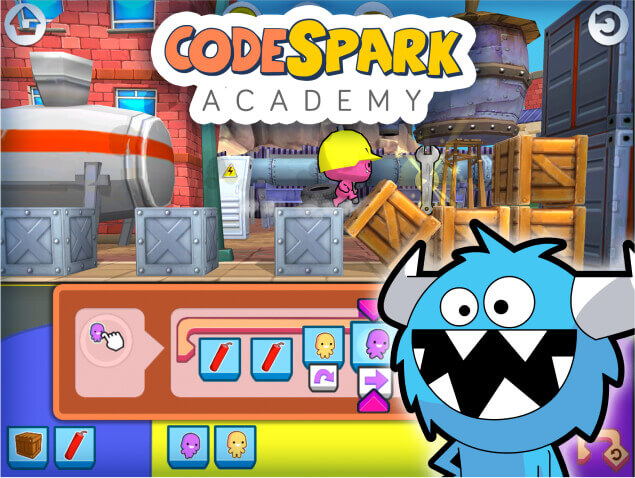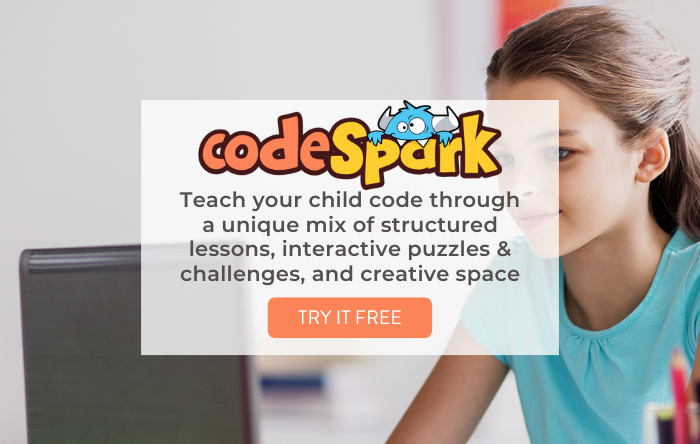STEM stands for Science, Technology, Engineering, and Mathematics, and it’s one of the fastest growing fields around. In fact, from 2011 to 2021, the STEM workforce grew by almost 20%.
STEM-related jobs include everything from scientists to software developers. Professors, data analysts, mechanical engineers, city planners, and astronauts are all based in the world of STEM, along with hundreds of other innovative careers.
As a result, STEM skills are being taught in schools earlier than in the past and more comprehensively. While elementary schoolers used to only tackle basic math and science, they’re now being exposed to engaging engineering and tech concepts too.
If you have a young one at home and want to help them get started on the right foot with STEM, look no further.
I’ve compiled 8 simple suggestions to help you introduce your child to STEM.
1. Have Fun with Apps
 codeSpark Academy
codeSpark Academy
codeSpark is a fun, engaging coding app that teaches kids basic problem solving, critical thinking skills, creativity, and a host of other valuable skills. Kids will enjoy playing on the app, not even realizing how much they're learning along the way as they get prepared for the world of tomorrow.
Technology is everywhere, so harness its power for good!
Instead of letting your child scroll mindlessly, put their screen time to work by utilizing meaningful, data-driven STEM apps that are tailored to their needs and abilities.
I recommend coding apps like codeSpark academy, designed specifically to teach coding fundamentals to the pre-reading crowd.
Based on research from MIT and Princeton, the app takes your child on a STEM journey complete with fun characters and engaging games… all designed to help them learn the basics of coding and problem solving.
The app is word-free, ad-free, and doesn’t require any experience, so you can let your child play independently.
Though the colorful, intuitive lessons on codeSpark feel like pure play, they’re actually helping your child build their logical reasoning as they learn how to code.
You can test drive codeSpark with a 7-day free trial to see all the STEM skills it can offer your child.
2. Let Them Experiment
Jump into STEM by conducting simple experiments at home… no fancy supplies needed!
You don’t have to wait until your child is reading or ready for school, either. Instead, add easy experiments into their everyday activities.
During bath time, let your little one test if certain objects will sink or float.
Give them some simple items (a cup, a ball, a toy car, an action figure) and have them predict what they think will happen.
You can have them run a similar experiment on a sunny day by letting them predict which items they think will melt in the sunshine.
Will a pat of butter melt? A Lego? Place each substance in the cup of a muffin tin and let them collect the results!
Experiments with food, shadows, and water are easy to do and can promote your child’s critical thinking and predictive skills.
Even though these activities don’t take a lot of planning on your part, they do wonders for introducing your child to the world of STEM.
3. Get Outside
Spending time outside helps your child get ready for all kinds of STEM concepts.
Encourage your child to observe the natural world around them. What does the sky look like on a rainy day? What do the clouds look like when it’s sunny?
Notice the animals around you. Where do they live? How do their bodies help them go about their days?
Check out nearby plants and trees. What colors are they? How do they change from season to season?
Letting your child collect these firsthand observations of the natural world will help them become more detail-oriented.
They’ll also develop a stronger appreciation for all the amazing ways plants and animals adapt to their environments.
Taking time to get outdoors and make observations will prime your child’s brain for all kinds of scientific fields, from meteorology to biology to chemistry to physics!
4. Start Building
Building is a great way to keep little ones busy… and to help them learn about engineering.
Let your kiddos build and play with all kinds of different materials.
Whether they’re making towers with blocks or sculptures with Play-Doh, they’ll be making all kinds of discoveries about gravity and space.
You don’t have to invest in state-of-the-art toys to encourage a love of building and designing.
Kids can create masterpieces with old boxes and paper towel rolls.
Challenge your child to see how tall they can make their tower, or how strong they can make their wall.
Don’t forget to encourage them to think about what works and what doesn’t as they build… and resist the parental urge to tell them how to do it!
Instead, stand back and let them discover.
You’ll be surprised at the innovative solutions they come up with… just through playing!
5. Read, Read, Read
Reading is key to so many aspects of education.
Reading to our children improves everything from their comprehension skills to their imagination and sense of empathy.
It’s no surprise that reading boosts STEM readiness, too!
There are STEM-related books available on just about every subject, for every age level imaginable.
Explore books about outer space, cool animals, wacky weather, or interesting habitats.
Check out stories that tell about scientists, astronauts, or important mathematicians.
STEM books can teach exciting new facts while helping our children boost their literacy skills at the same time.
You don’t need to spend a fortune. Check out books from your local library, explore Little Free Libraries or book swaps, and peruse eBooks for free online.
The more our kids read (and listen to us read) about STEM subjects, the more interested they’ll be in pursuing these topics on their own.
6. Connect With Your Community
Another great way to build enthusiasm for STEM is by checking out community-related activities.
Maybe there’s a science museum or nature center nearby where you can take your child for a day of STEM-related research and fun.
Aquariums, zoos, and petting farms can also be great field experiences for budding scientists, engineers, and mathematicians.
Some communities even offer STEM-related day camps and workshops for young kids. Do a little digging to see if there’s something your child might want to attend.
Check with your local library, elementary school, or community center, and reach out to other parents through social media or around your neighborhood.
A STEM-related field trip is sure to be an experience that stands out in your child’s memory… and may be a great way for them to discover new interests and skills.
7. Ask a Lot of Questions
Get in the habit of asking a lot of questions when you notice everyday phenomena.
Your child doesn’t have to know the answer… instead, you’re helping activate their innate curiosity about the world around them.
Notice a hole in a nearby fence? Discuss with your child what might have caused it.
See a rust stain around a pipe? Ask them why they think it’s there.
Effortlessly add in math questions too, such as how many cars are left in the parking lot after you leave, or how many balloons are in a bunch by the grocery store.
You can even practice stating things in an “if/then” hypothesis format. “If it gets colder tonight, then will that puddle freeze?”
Prompting your child to ask questions and look for solutions today sets them up to be thoughtful problem solvers and scientists tomorrow.
8. Teach Them to Trust in the Process
Mistakes happen.
They happen in STEM fields a LOT!
In fact, learning through errors is one of the most effective ways to make new discoveries in science, math, engineering, and tech.
Make sure to continually emphasize that it’s okay to guess wrongly, try something that doesn’t work, or mess up on an experiment.
Instead of focusing on what they did “wrong,” help your child focus on what they can try differently next time.
This builds their resilience and opens their mind to new possibilities, instead of bogging down on past mistakes.
Learning that mistakes are part of the process is an important part of STEM… and an important life lesson, too.
The sooner kids internalize this truth, the less likely they are to feel discouraged when they hit a roadblock.
Final Thoughts
Kids are naturally inclined to excel at STEM from a young age.
They’re curious, inquisitive, resilient, and eager to experiment.
You can draw on your child’s natural STEM abilities by incorporating these eight simple suggestions into your daily routine.
Create simple experiments.
Observe nature.
Play through building.
Explore new tech skills.
Read fascinating books.
Get out into the community.
Ask questions.
Make mistakes.
And above all, watch your child grow, discover, and shine as you introduce them to the amazing world of STEM.
Are you a parent of a young child interested in STEM? Do you have additional ideas on how to foster a love of science, tech, engineering, or math? We’d love to hear from you in the comments below!


